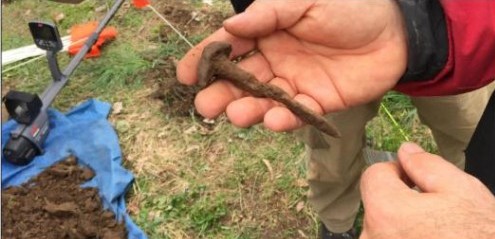 N&W’s Richard A. Geidel, R.P.A., Senior Archaeologist, recently attended a metal detecting workshop and field training that yielded artifacts from the site of French and Indian era Fort Halifax in Pennsylvania.
N&W’s Richard A. Geidel, R.P.A., Senior Archaeologist, recently attended a metal detecting workshop and field training that yielded artifacts from the site of French and Indian era Fort Halifax in Pennsylvania.
“The metal detecting training was a real eye-opener,” states Geidel. Since the 1980s the use of metal detectors on archaeology projects has become more and more mainline, with often spectacular results for site documentation and interpretation. Of course, its utilization is largely restricted to historic sites, especially battlefields and other military sites. When some historic sites that were previously examined by traditional archaeological testing were re-examined using metal detecting, there were dramatic increases in the artifact assemblage recovered (sometimes on the order of multiple orders of magnitude) as well as the recovery of important information about activity patterning that simply was not detected with traditional test excavations. Metal detecting doesn’t provide a full understanding of these sites, but it can provide guidance that allows more traditional excavation strategies to be more focused and effective.
The training was conducted on the property that was the site of the French and Indian era Fort Halifax. The specific fort location remains elusive, but even in two days of metal detecting by about twenty-five inexperienced operators, the participants were able to find two spikes used in the fort’s construction, as well as lead musket balls and other metal artifacts that likely are associated with the fort. Hundreds of metal artifacts associated with the farmstead (also now long gone) that occupied the site in the 19th century were also identified.
Metal detecting clearly is a valuable and cost-effective tool for the initial investigation of almost any archaeological project. While its effectiveness in identifying prehistoric sites is limited, the methodology provides substantial advantages in identifying and interpreting historic sites. Obviously, the effectiveness of metal detecting is a function of the quality of machines used and the experience of the operators. The course instructors emphasized that the second factor is usually far more important than the first.
Geidel stated, “Our results over the weekend demonstrated that even beginners can be fairly proficient with the technique.” There are some gains in sensitivity and depth of coverage with more expensive detectors, but depending on soil characteristics, even low-end machines generally provide adequate capability to assess the plow zone. Investigating undisturbed soils below the plow zone usually requires more traditional archaeological strategies, but metal detecting can continue to provide some guidance in identifying cultural features that intrude into the in situ soil horizons.
